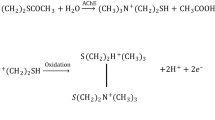Abstract
Using tetraethoxysilane and 3-aminopropyltriethoxysilane as the silica sources, amino-functionalized mesoporous silica thin films with 3-dimensional cubic structure have been deposited on conducting ITO substrate in the presence of surfactant F127 templates under acid conditions. The acetylcholinesterase (AchE) and cytochrome c (Cyt c) were incorporated into the pores of mesoporous thin films, and an amperometric biosensor was obtained. After adsorption of AchE and Cyt c, the ordered cubic structure of mesoporous silica and the bioactivities and electrochemical activities of the immobilized protein and enzyme molecules were retained. The sensor properties of the biosensor were investigated by using acetylthiocholine iodide as the substrate and Cyt c as the electron transfer mediator. The inhibition versus the logarithm of concentration was found to be linear to organophosphorus pesticide dichlorvos over the concentration ranges of 1.0×10−8 mol/L to 1.0×10−3 mol/L with the detection limit of 3.1×10−9 mol/L.
Similar content being viewed by others
References
Hartmann M. Ordered mesoporous materials for bioadsorption and biocatalysis. Chem Mater, 2005, 17: 4577–4593
Yiu H H P, Wright P A, Botting N P. Enzyme immobilization using siliceous mesoporous molecular. Micropor Mesopor Mater, 2001, 44/45: 763–769
Deere J, Magner E, Wall J G, et al. Adsorption and activity of proteins onto mesoporous silica. Catal Lett, 2003, 85: 19–23
Vinu A, Murugesan V, Tangermann O, et al. Adsorption of cytochrome c on mesoporous molecular sieves: Influence of pH, pore diameter, and aluminum incorporation. Chem Mater, 2004, 16: 3056–3065
Moelans D, Cool P, Baeyens J, et al. Immobilisation behaviour of biomolecules in mesoporous silica materials. Cata Commun, 2005, 6: 591–595
Qiao S Z, Djojoputro H, Hu Q, et al. Synthesis and lysozyme adsorption of rod-like large-pore periodic mesoporous organosilica. Prog Solid State Ch, 2006, 34: 249–256
Miyahara M, Vinu A, Hossain K Z, et al. Adsorption study of heme proteins on SBA-15 mesoporous silica with pore-filling models. Thin Solid Films, 2006, 499: 13–18
Kresge C T, Leonowicz M E, Roth W J, et al. Ordered mesoporous molecular sieves synthesized by a liquid-crystal template mechanism. Nature, 1992, 359: 710–712
Xiao F S, Han Y, Yu Y, et al. Stable ordered mesoporous titanosilicates with highly active sites. J Am Chem Soc, 2002, 124: 888–889
Kisler J M, Dahler A, Stevens G W, et al. Separation of biological molecules using mesoporous molecular sieves. Micropor Mesopor Mater, 2001, 44/45: 769–774
Okada H, Nakajima N, Tanaka T, et al. Improvement in photocyclization efficiency of diaryl ethenes by adjusting the pore size of mesoporous silica. Angew Chem Int Ed, 2005, 44: 7233–7236
Pardo E, Burguete P, Ruiz-Garcia R, et al. Ordered mesoporous silicas as host for the incorporation and aggregation of octanuclear nickel(II) single-molecule magnets: A bottom-up approach to new magnetic nanocomposite materials. J Mater Chem, 2006, 16: 2702–2714
Zhang X A, Wu W J, Man Y H, et al. Preparation and photochromism of Keggin-type molybdphosphoric acid/silica mesoporous composite thin films. Sci China Ser B-Chem, 2007, 50: 318–326
Rohlfing D F, Rathousky J, Rohlfing Y, et al. Functionalized mesoporous silica films as a matrix for anchoring electrochemically active guests. Langmuir, 2005, 21: 11320–11329
Deere J, Serantoni M, Edler K J, et al. Measurement of the adsorption of cytochrome c onto the external surface of a thin-film mesoporous silicate by ellipsometry. Langmuir, 2004, 20: 532–536
Zhang X A, Wu W J, Wang J F, et al. Immobilization and electrochemistry of cytochrome c on amino-functionalized mesoporous silica thin films. Electrochem Commun, 2007, 9: 2098–2104
Zhao D, Yang P, Melosh N, et al. Continuous mesoporous silica films with highly ordered large pore structures. Adv Mater, 1998, 10: 1380–1385
Washmon-Kriel L, Jimenez V L, Balkus K J Jr. Cytochrome c immobilization into mesoporous molecular sieves. J Mol Catal B: Enzymatic, 2000, 10: 453–469
Li L D, Li W J, Sun C Q, et al. Fabrication of carbon paste electrode containing 1:12 phosphomolybdic anions encapsulated in modified mesoporous molecular sieve MCM-41 and its electrochemistry. Electroanalysis, 2002, 14: 368–375
Dai Z H, Ju H X. Direct electron transfer of protein immobilized on mesoporous molecular sieves matrix (in Chinese). Acta Phys-Chim Sin, 2004, 20: 1262–1266
Xu X, Tian B, Kong J, et al. Ordered mesoporous niobium oxide film: A novel matrix for assembling functional proteins for bioelectrochemical applications. Adv Mater, 2003, 15: 1932–1936
Fattakhova-Rohlfing D, Brezesinski T, Rathouský J, et al. Transparent conducting films of indium tin oxide with 3D mesopore architecture. Adv Mater, 2006, 18: 2980–2983
Suprun E, Evtugyn G, Budnikov H, et al. Acetylcholinesterase sensor based on screen-printed carbon electrode modified with Prussian blue. Anal Bioanal Chem, 2005, 383: 597–604
Ivanov A, Evtugyn G, Budnikov H, et al. Cholinesterase sensors based on screen-printed electrodes for detection of organophosphorus and carbamic pesticides. Anal Bioanal Chem, 2003, 377: 624–631
Lee H S, Kin Y A, Chao Y A, et al. Oxidation of organophosphorus pesticides for the sensitive detection by a cholinesterase-based biosensor. Chemosphere, 2002, 46: 571–576
Author information
Authors and Affiliations
Corresponding author
Additional information
Supported by the Advanced Research Foundation of National University of Defense Technology (Grant No. JC08-02-08)
About this article
Cite this article
Zhang, X., Jia, H., Wang, X. et al. Biosensors based on acetylcholinesterase immobilized on mesoporous silica thin films. Chin. Sci. Bull. 54, 3023–3028 (2009). https://doi.org/10.1007/s11434-009-0441-7
Received:
Accepted:
Published:
Issue Date:
DOI: https://doi.org/10.1007/s11434-009-0441-7




